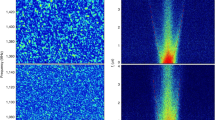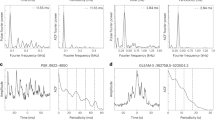Abstract
IF pulsars are accelerated by the emission of asymmetric magnetic dipole1 or neutrino2 radiation, the spatial velocity acquired should lie along its axis of rotation. A simple test3 of such models is that the position angle on the sky of the proper motion ϕv and the polarization plane at the peak of the pulse profile ϕp should be either parallel or perpendicular. This hypothesis does not appear to be borne out by the available observations4. We have proposed5 a more direct 'scalar' test of the acceleration idea: the tangential velocity Vt of a pulsar (that is, the projection of its actual spatial velocity) should be proportional to the sine of the angle ζ between the line of sight and the rotation axis.
This is a preview of subscription content, access via your institution
Access options
Subscribe to this journal
Receive 51 print issues and online access
$199.00 per year
only $3.90 per issue
Buy this article
- Purchase on Springer Link
- Instant access to full article PDF
Prices may be subject to local taxes which are calculated during checkout
Similar content being viewed by others
References
Tademaru, E. P. & Harrison, E. R. Nature 254, 676–677 (1975).
Dorofeev, O. F., Rodionov, V. N. & Ternov, I. M. JETP Lett. 40, 159–161 (1984).
Morris, D., Radhakrishnan, V. & Shukre, C. Nature 260, 124–126 (1976).
Anderson, B. & Lyne, A. G. Nature 303, 597–599 (1983).
Pskovsky, Yu. P. & Dorofeev, O. F. Astr. circ (USSR) 1504, 1–2 (1987).
Lyne, A. G., Anderson, B. & Salter, M. J. Mon. Not. R. astr. Soc. 201, 503–520 (1982).
Downs, G. S. & Reichley, P. E. Astrophys. J. Suppl. Ser. 53, 169–240 (1983).
Gwinn, C. R., Taylor, J. H., Weisberg, J. M. & Rawley, L. A. Astr. J. 91, 338–342 (1986).
Minkowski, R. L. Publs Astr. Soc. Pacif. 82, 470–478 (1970).
Helfand, D. J., Taylor, J. H., Backus, P. R. & Cordes, J. M. Astrophys. J. 237, 206–215 (1980).
Cordes, J. M. Astrophys. J. 311, 183–196 (1986).
Malov, I. F. Astrophysics 24, 507–522 (1986).
Lyne, A. G. & Manchester, R. N. Mon. Not. R. astr. Soc. 234, 477–508 (1988).
Morris, D. et al. Astr. Astrophys. 73, 46–53 (1979).
Manchester, R. N. Astrophys. J. 172, 43–52 (1972).
Manchester, R. N. Astrophys. J. 188, 637–643 (1974).
Hamilton, P. A. & Lyne, A. G. Mon. Not. R. astr. Soc. 224, 1073–1081 (1987).
Radhakrishnan, V. & Cooke, D. J. Astrophys. Lett. 3, 225–229 (1969).
Author information
Authors and Affiliations
Rights and permissions
About this article
Cite this article
Pskovsky, Y., Dorofeev, O. The acceleration of pulsars—a new test. Nature 340, 701–702 (1989). https://doi.org/10.1038/340701a0
Received:
Accepted:
Issue Date:
DOI: https://doi.org/10.1038/340701a0
This article is cited by
-
Spatial velocities of pulsars
Journal of Astrophysics and Astronomy (1990)
Comments
By submitting a comment you agree to abide by our Terms and Community Guidelines. If you find something abusive or that does not comply with our terms or guidelines please flag it as inappropriate.



